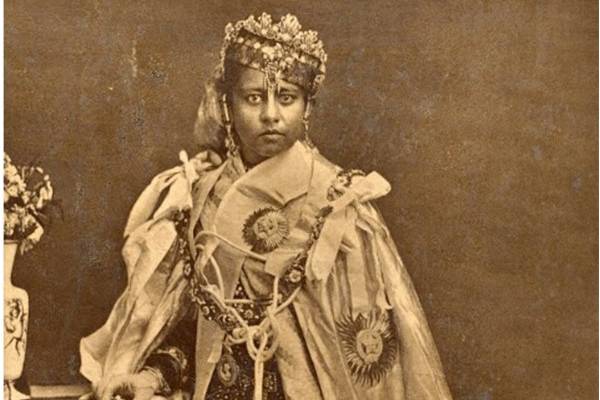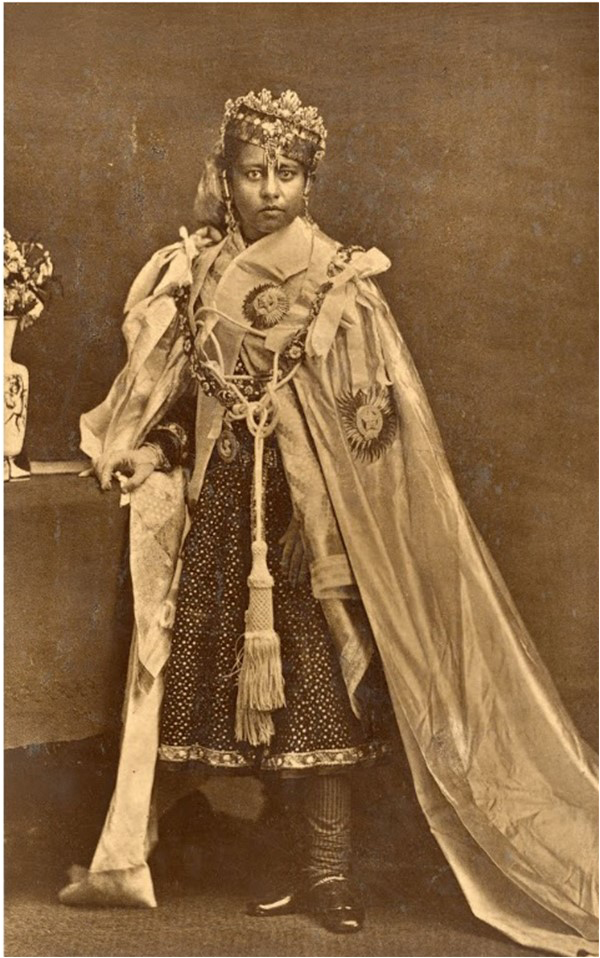
One of the earliest photographs of royal women in India—a formal portrait of the third Begum of Bhopal, Nawab Shah Jahan Begum, G.C.S.I. The Begums of Bhopal were some of the most enlightened female rulers, who ruled in their own legal and constitutional right for 150 years out of the kingdom’s 240-year-old existence. Overcoming the patriarchal structures of kingship, religious dogma and the social prejudices of the period, these women played extremely decisive, empowering and affective roles, unprecedented in Islamic political history.
This image is from an album given to Queen Victoria by Dr John William Tyler on January 15th 1887. In it, the third Begum of Bhopal is seen symbolically swearing loyalty to Britain by wearing the mantle, collar, sash, and insignia of the Most Exalted Order of the Star of India. While in the context of this photograph the Begum’s fusion of British symbols with traditional clothes and headdress may appear incongruous, the cultural and symbolic cross-dressing is unremarkable when one considers the pro-British stance of successive generations of the rulers of Bhopal.

This photograph was produced by Bourne and Shepherd Studios, one of the well known studios in colonial India. It was established by Samuel Bourne who worked in India between 1863 and 1869, travelling the length of the country and producing many fine studies of the landscape and architecture of India. In 1863, Bourne, in partnership with William Howard established the photographic studio ‘Howard & Bourne’ in Shimla, which then expanded to include Charles Shepherd. After Howard left the studio in 1866, the studio was renamed as ‘Bourne & Shepherd’ and the establishment set up a branch in Calcutta – a studio which runs its business to the present day. Charles Shepherd managed the studio’s core portrait business and supervised the printing and marketing of his negatives, Samuel Bourne travelled extensively throughout India, producing topographical and architectural views. This image is part of an online exhibit by Google Arts and Culture titled: Maharanis: Women of Royal India.
This image is from an album given to Queen Victoria by Dr John William Tyler on January 15th 1887. In it, the third Begum of Bhopal is seen symbolically swearing loyalty to Britain by wearing the mantle, collar, sash, and insignia of the Most Exalted Order of the Star of India. While in the context of this photograph the Begum’s fusion of British symbols with traditional clothes and headdress may appear incongruous, the cultural and symbolic cross-dressing is unremarkable when one considers the pro-British stance of successive generations of the rulers of Bhopal.

This photograph was produced by Bourne and Shepherd Studios, one of the well known studios in colonial India. It was established by Samuel Bourne who worked in India between 1863 and 1869, travelling the length of the country and producing many fine studies of the landscape and architecture of India. In 1863, Bourne, in partnership with William Howard established the photographic studio ‘Howard & Bourne’ in Shimla, which then expanded to include Charles Shepherd. After Howard left the studio in 1866, the studio was renamed as ‘Bourne & Shepherd’ and the establishment set up a branch in Calcutta – a studio which runs its business to the present day. Charles Shepherd managed the studio’s core portrait business and supervised the printing and marketing of his negatives, Samuel Bourne travelled extensively throughout India, producing topographical and architectural views. This image is part of an online exhibit by Google Arts and Culture titled: Maharanis: Women of Royal India.

